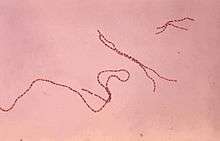Coprococcus eutactus
| Coprococcus eutactus | |
|---|---|
 | |
| Scientific classification | |
| Domain: | Bacteria |
| Phylum: | Firmicutes |
| Class: | Clostridia |
| Order: | Clostridiales |
| Family: | Lachnospiraceae |
| Genus: | Coprococcus |
| Species: | C. eutactus |
| Binomial name | |
| Coprococcus eutactus Holdeman & Moore, 1974 | |
Coprococcus (ATCC 27759) is a genus of anaerobic cocci which are all part of the human faecal flora, but rarely seen in human clinical specimens. [1] "Coprococcus includes those gram-positive, anaerobic cocci that actively ferment carbohydrates, producing butyric and acetic acids with formic or propionic and/or lactic acids. Fermentable carbohydrates are either required or are highly stimulatory for growth and continued subculture." - Lillian V. Holdeman & W. E. C. Moore. The genus is bio-chemically closely related to Ruminococcus, and phylogenetically to the genus Lachnospira.
Coprococcus eutactus is an obligately anaerobic, nonmotile, gram-positive coccus occurring in pairs or chains of pairs. Cells may lose colour readily and acquire a slightly elongate shape in a medium containing a fermentable carbohydrate, but are normally round, and 0.7 to 1.3 µm in diameter. [2]
Coprococcus may be used as a microbial biomarker to assess the health of the human gastro-intestinal tract. Gut microorganisms maintain gastro-intestinal health and the mounting evidence of gastro-intestinal problems in autistic children makes a link between autism and intestinal microbiota highly probable, but the paucity of data on intestinal microflora means a definite link has not yet been demonstrated. Early studies overlooked potentially beneficial gut flora missing in autistic children. [3]
Coprococcus species
- C. catus Holdeman & Moore
- C. comes Holdeman & Moore
Etymology
'kopros' - excrement, faeces; 'kokkos' - berry; 'Coprococcus' - faecal coccus
'eutaktos' - orderly, well-disciplined (referring to the uniform reactions of the different strains)